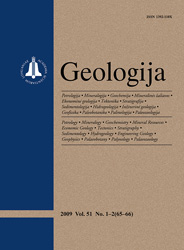Geologija / Geology
WHAT?
 ISSN 1392-110X ISSN 2029-056X (online) |
2008 m. Nr. 2 On the Eastern Baltic environment changes: a case study of the Curonian Lagoon area
Sea level fluctuation, neotectonic movement, variation of sedimentation conditions, human impact play an important role in sea development. Water level fluctuation and vertical movements determine the rates of the long-term sedimentation process. The sea level rises (sinking of coasts south of 56° N), and its amplitude increases from 1.5 mm y–1 (in the beginning of the 20th century) to 3–4 mm y–1 (predicted for the 22nd century). The rise of coasts (sinking of sea level) and uplift is evident in the central and especially northern Baltic (1–9 mm y–1). These factors speed up the erosion of shallow areas, eutrophication and rapid accumulation of sedimentary matter in local lagoons. The latter processes complicate the ecological situation in the shallow (mouth) areas. Human activity takes place in the river areas, lagoons and geochemical barriers. The mentioned factors modifity the rates of sedimentation (0.6–15 mm y–1) in the Baltic Sea basin, which reach their maximum in the shallow lagoons of the Eastern Baltic (2.5–15.0 mm y–1). A synthesis of the data obtained by the author and information contained in references made it possible to make a many-sided forecast regarding a more than a thousand-year development of the Curonian Lagoon and the Eastern Baltic. A rapid transformation of coasts will take place, the nearshore basins – Viainameri (Estonia), the Gulf of Riga, the Curonian and Vistula lagoons, the Puck Bay – will shallow. Nearby new shallow lagoons will appear in the place of these basins. The Eastern Baltic lagoons (Curonian and Vistula) in future will become similar to the present state of the Polish Pomeranian coastal zone where the Leba, Gardno and other lakes which used to be vast lagoons are in the final stage of degradation. The predicted development of the Eastern baltic will take place if the range of tectonic movements and sea level changes remains the same and there will be no human invasion with supermodern technologies into the natural processes. Keywords: sedimentation rates, vertical movements, sea level changes, the Curonian Lagoon, Eastern Baltic Sea basin |
Issues:
2011 - Vol.53 No. 1, No. 2, No. 3 2010 - Vol.52 No. 1-4 2009 - Vol.51 No. 1-2, No. 3-4 2008 - Vol.50 No. 1, No. 2, No. 3, No. 4, No. Priedas 2007 No. 1, No. 2, No. 3, No. 4 2006 No. 1, No. 2, No. 3, No. 4 2005 No. 1, No. 2, No. 3, No. 4 2004 No. 1, No. 2, No. 3, No. 4 2003 No. 1, No. 2, No. 3, No. 4 2002 No. 1, No. 2, No. 3, No. 4 2001 No. 1, No. 2, No. 3, No. 4 |